belt KIA CARENS RHD 2018 Owners Manual
[x] Cancel search | Manufacturer: KIA, Model Year: 2018, Model line: CARENS RHD, Model: KIA CARENS RHD 2018Pages: 723, PDF Size: 40.94 MB
Page 19 of 723
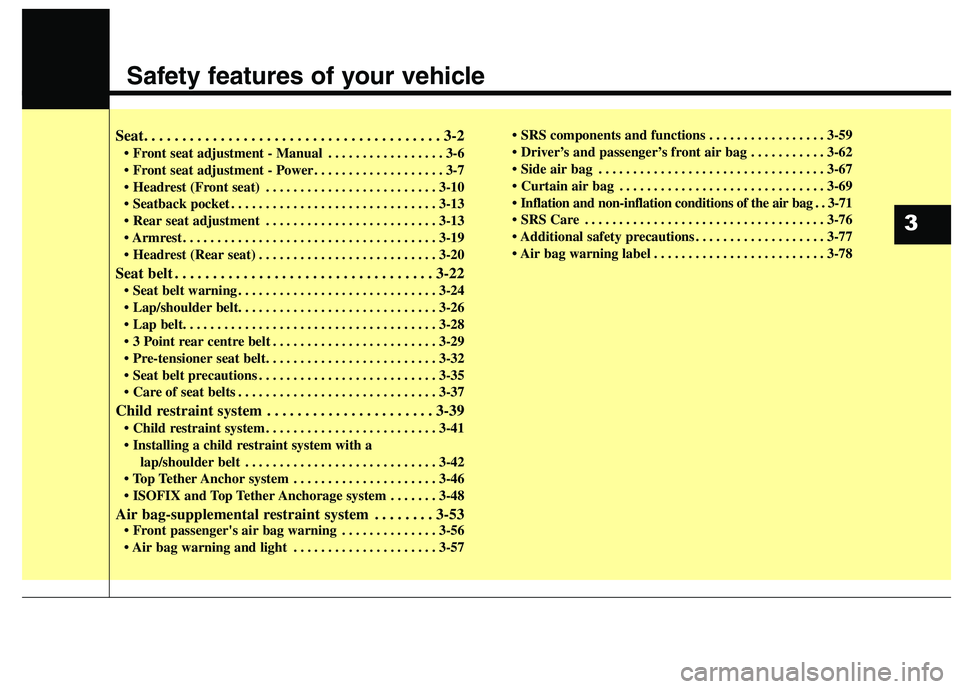
Safety features of your vehicle
3
Seat. . . . . . . . . . . . . . . . . . . . . . . . . . . . . . . . . . . . . . . 3-2 • Front seat adjustment - Manual . . . . . . . . . . . . . . . . . 3-6
. . . . . . . . . . . . . . . . . . . 3-7
. . . . . . . . . . . . . . . . . . . . . . . . . 3-10
. . . . . . . . . . . . . . . . . . . . . . . . . . . . . . 3-13
. . . . . . . . . . . . . . . . . . . . . . . . . 3-13
. . . . . . . . . . . . . . . . . . . . . . . . . . . . . . . . . . . . . 3-19
. . . . . . . . . . . . . . . . . . . . . . . . . . 3-20
Seat belt . . . . . . . . . . . . . . . . . . . . . . . . . . . . . . . . . . 3-22 . . . . . . . . . . . . . . . . . . . . . . . . . . . . . 3-24
. . . . . . . . . . . . . . . . . . . . . . . . 3-29
. . . . . . . . . . . . . . . . . . . . . . . . . . 3-35
. . . . . . . . . . . . . . . . . . . . . . . . . . . . . 3-37
Child restraint system . . . . . . . . . . . . . . . . . . . . . . 3-39 . . . . . . . . . . . . . . . . . . . . . . . . . 3-41
lap/shoulder belt . . . . . . . . . . . . . . . . . . . . . . . . . . . . 3-42
. . . . . . . . . . . . . . . . . . . . . 3-46
. . . . . . . 3-48
Air bag-supplemental restraint system . . . . . . . . 3-53 . . . . . . . . . . . . . . 3-56
. . . . . . . . . . . . . . . . . . . . . 3-57 . . . . . . . . . . . . . . . . . 3-59
. . . . . . . . . . . 3-62
. . . . . . . . . . . . . . . . . . . . . . . . . . . . . . . . . 3-67
. . . . . . . . . . . . . . . . . . . . . . . . . . . . . . 3-69
. . 3-71
. . . . . . . . . . . . . . . . . . . . . . . . . . . . . . . . . . . 3-76
. . . . . . . . . . . . . . . . . . . 3-77
. . . . . . . . . . . . . . . . . . . . . . . . . 3-78
Page 21 of 723
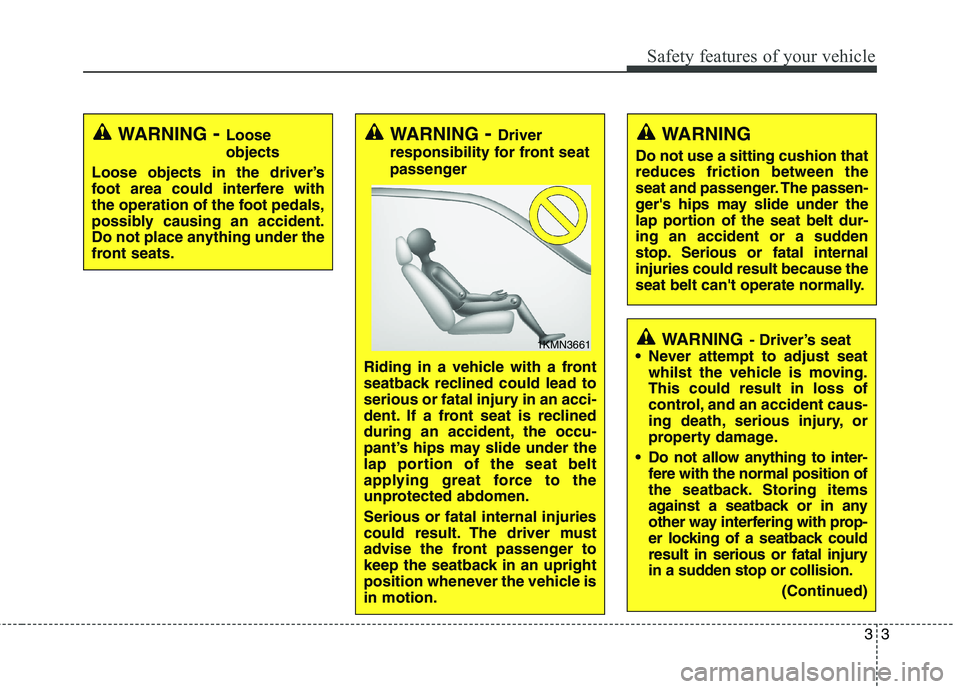
33
Safety features of your vehicle
WARNING- Loose objects
Loose objects in the driver’s
foot area could interfere with
the operation of the foot pedals,
possibly causing an accident.
Do not place anything under the
front seats.WARNING - Driver
responsibility for front seat
passenger
Riding in a vehicle with a front
seatback reclined could lead to
serious or fatal injury in an acci-
dent. If a front seat is reclined
during an accident, the occu-
pant’s hips may slide under the
lap portion of the seat belt
applying great force to the
unprotected abdomen. Serious or fatal internal injuries
could result. The driver must
advise the front passenger to
keep the seatback in an upright
position whenever the vehicle isin motion.
1KMN3661
WARNING
Do not use a sitting cushion that reduces friction between the
seat and passenger. The passen-
ger's hips may slide under the
lap portion of the seat belt dur-
ing an accident or a sudden
stop. Serious or fatal internalinjuries could result because the
seat belt can't operate normally.
WARNING - Driver’s seat
Never attempt to adjust seat whilst the vehicle is moving. This could result in loss of
control, and an accident caus-
ing death, serious injury, or
property damage.
Do not allow anything to inter- fere with the normal position of
the seatback. Storing items
against a seatback or in any
other way interfering with prop-
er locking of a seatback could
result in serious or fatal injury
in a sudden stop or collision.
(Continued)
Page 22 of 723
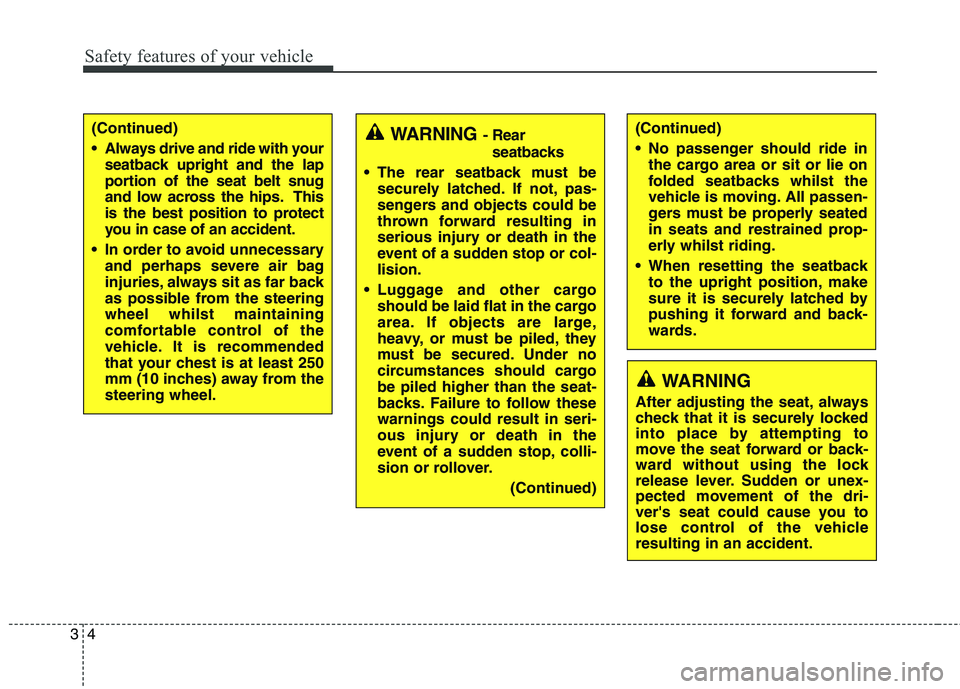
Safety features of your vehicle
4
3
(Continued)
No passenger should ride in
the cargo area or sit or lie on
folded seatbacks whilst the
vehicle is moving. All passen-
gers must be properly seated
in seats and restrained prop-
erly whilst riding.
When resetting the seatback to the upright position, make
sure it is securely latched by
pushing it forward and back-
wards.
WARNING
After adjusting the seat, always
check that it is securely locked
into place by attempting to
move the seat forward or back-
ward without using the lock
release lever. Sudden or unex-
pected movement of the dri-
ver's seat could cause you to
lose control of the vehicleresulting in an accident.
(Continued)
Always drive and ride with your seatback upright and the lap
portion of the seat belt snug
and low across the hips. This
is the best position to protect
you in case of an accident.
In order to avoid unnecessary and perhaps severe air bag
injuries, always sit as far back
as possible from the steeringwheel whilst maintaining
comfortable control of the
vehicle. It is recommended
that your chest is at least 250
mm (10 inches) away from thesteering wheel.WARNING - Rear
seatbacks
The rear seatback must be securely latched. If not, pas-
sengers and objects could be
thrown forward resulting in
serious injury or death in the
event of a sudden stop or col-lision.
Luggage and other cargo should be laid flat in the cargo
area. If objects are large,
heavy, or must be piled, they
must be secured. Under no
circumstances should cargobe piled higher than the seat-
backs. Failure to follow thesewarnings could result in seri-
ous injury or death in the
event of a sudden stop, colli-
sion or rollover.
(Continued)
Page 23 of 723
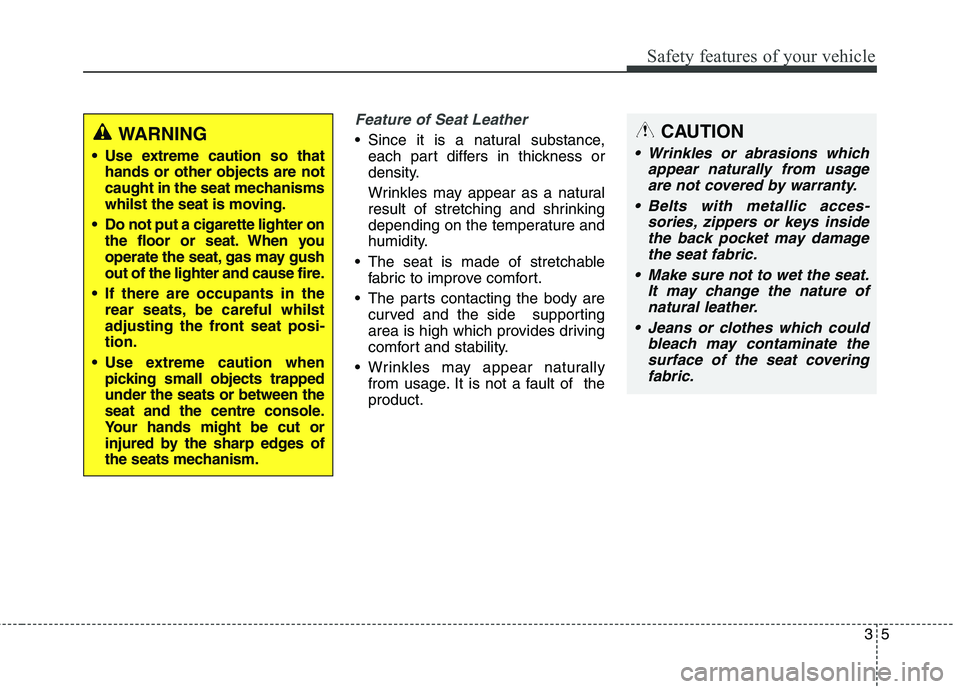
35
Safety features of your vehicle
Feature of Seat Leather
Since it is a natural substance,each part differs in thickness or
density.
Wrinkles may appear as a natural
result of stretching and shrinking
depending on the temperature and
humidity.
The seat is made of stretchable fabric to improve comfort.
The parts contacting the body are curved and the side supporting
area is high which provides driving
comfort and stability.
Wrinkles may appear naturally from usage. It is not a fault of theproduct.WARNING
Use extreme caution so that hands or other objects are not
caught in the seat mechanisms
whilst the seat is moving.
Do not put a cigarette lighter on the floor or seat. When you
operate the seat, gas may gush
out of the lighter and cause fire.
If there are occupants in the rear seats, be careful whilst
adjusting the front seat posi-tion.
Use extreme caution when picking small objects trappedunder the seats or between the
seat and the centre console.
Your hands might be cut or
injured by the sharp edges of
the seats mechanism.CAUTION
Wrinkles or abrasions which
appear naturally from usageare not covered by warranty.
Belts with metallic acces- sories, zippers or keys insidethe back pocket may damagethe seat fabric.
Make sure not to wet the seat. It may change the nature ofnatural leather.
Jeans or clothes which could bleach may contaminate thesurface of the seat coveringfabric.
Page 32 of 723
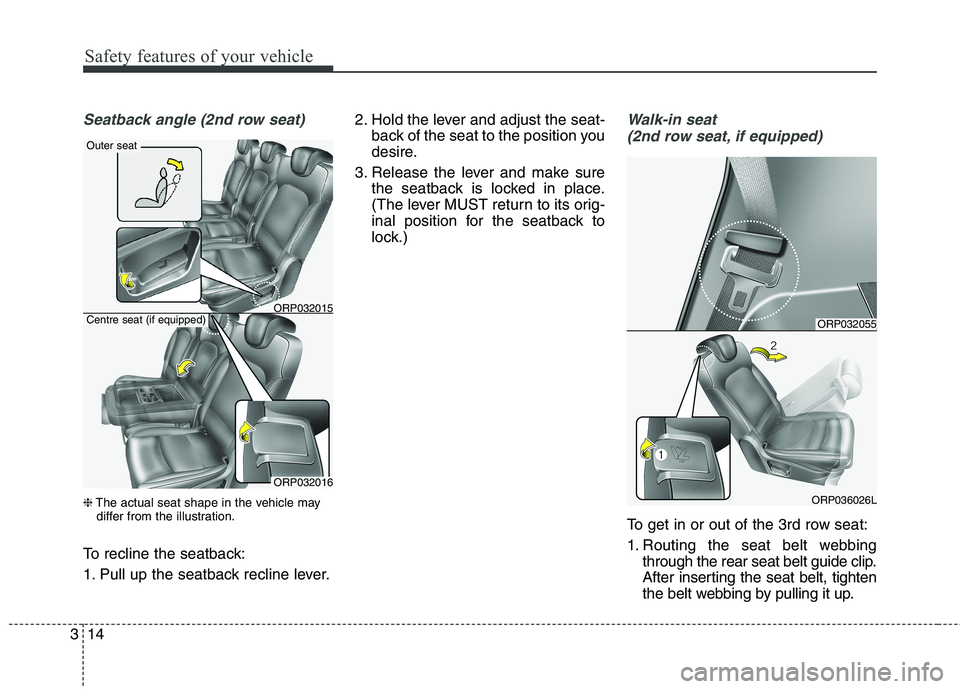
Safety features of your vehicle
14
3
Seatback angle (2nd row seat)
❈ The actual seat shape in the vehicle may
differ from the illustration.
To recline the seatback:
1. Pull up the seatback recline lever. 2. Hold the lever and adjust the seat-
back of the seat to the position you
desire.
3. Release the lever and make sure the seatback is locked in place.
(The lever MUST return to its orig-
inal position for the seatback to
lock.)
Walk-in seat
(2nd row seat, if equipped)
To get in or out of the 3rd row seat:
1. Routing the seat belt webbing through the rear seat belt guide clip.
After inserting the seat belt, tighten
the belt webbing by pulling it up.
ORP032055
ORP036026L
ORP032016
ORP032015
Outer seat
Centre seat (if equipped)
Page 33 of 723
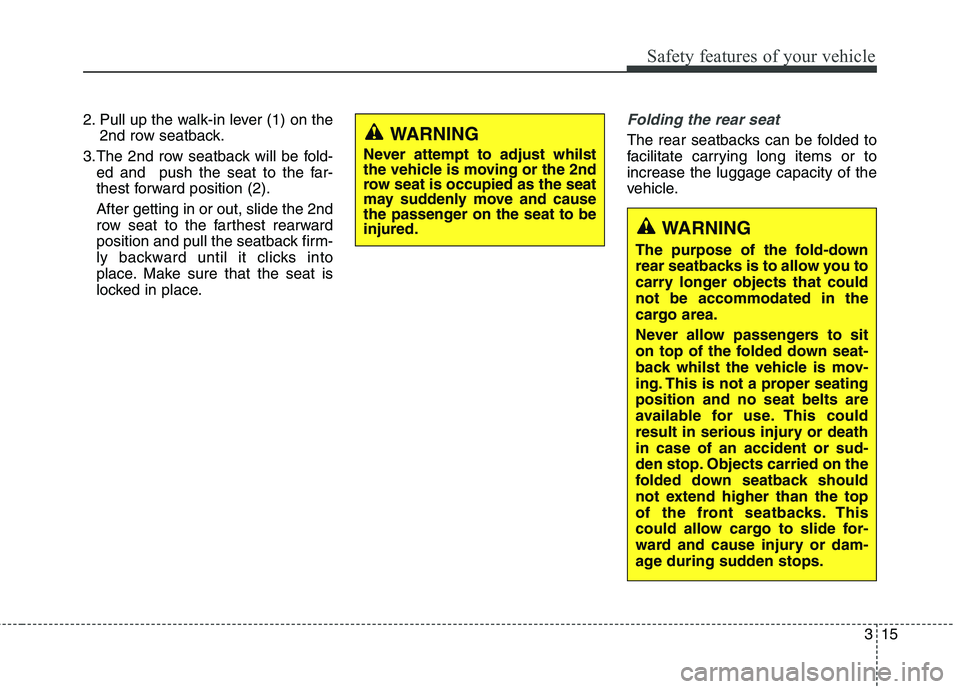
315
Safety features of your vehicle
2. Pull up the walk-in lever (1) on the2nd row seatback.
3.The 2nd row seatback will be fold- ed and push the seat to the far-
thest forward position (2). After getting in or out, slide the 2nd
row seat to the farthest rearward
position and pull the seatback firm-
ly backward until it clicks into
place. Make sure that the seat is
locked in place.Folding the rear seat
The rear seatbacks can be folded to
facilitate carrying long items or toincrease the luggage capacity of the
vehicle.
WARNING
The purpose of the fold-down
rear seatbacks is to allow you to
carry longer objects that couldnot be accommodated in the
cargo area.
Never allow passengers to sit
on top of the folded down seat-
back whilst the vehicle is mov-
ing. This is not a proper seatingposition and no seat belts are
available for use. This could
result in serious injury or deathin case of an accident or sud-
den stop. Objects carried on the
folded down seatback should
not extend higher than the top
of the front seatbacks. This
could allow cargo to slide for-
ward and cause injury or dam-
age during sudden stops.
WARNING
Never attempt to adjust whilst
the vehicle is moving or the 2nd
row seat is occupied as the seat
may suddenly move and cause
the passenger on the seat to beinjured.
Page 34 of 723

Safety features of your vehicle
16
3
To fold down the rear seatback
1. Insert the rear seat belt buckle in
the pocket between the rear seat-
back and cushion, and insert the
rear seat belt webbing in the guide
to prevent the seat belt from beingdamaged.
2. Set the front seatback to the upright position and if necessary,
slide the front seat forward.
3. Lower the rear headrests to the lowest position.2nd row seat3rd row seat (if equipped)
ORP032019/ORP032064/ORP032055/ORP032067/ORP032021
■■■■TTTTyyyyppppeeee AAAA■■■■TTTTyyyyppppeeee BBBB
Page 35 of 723
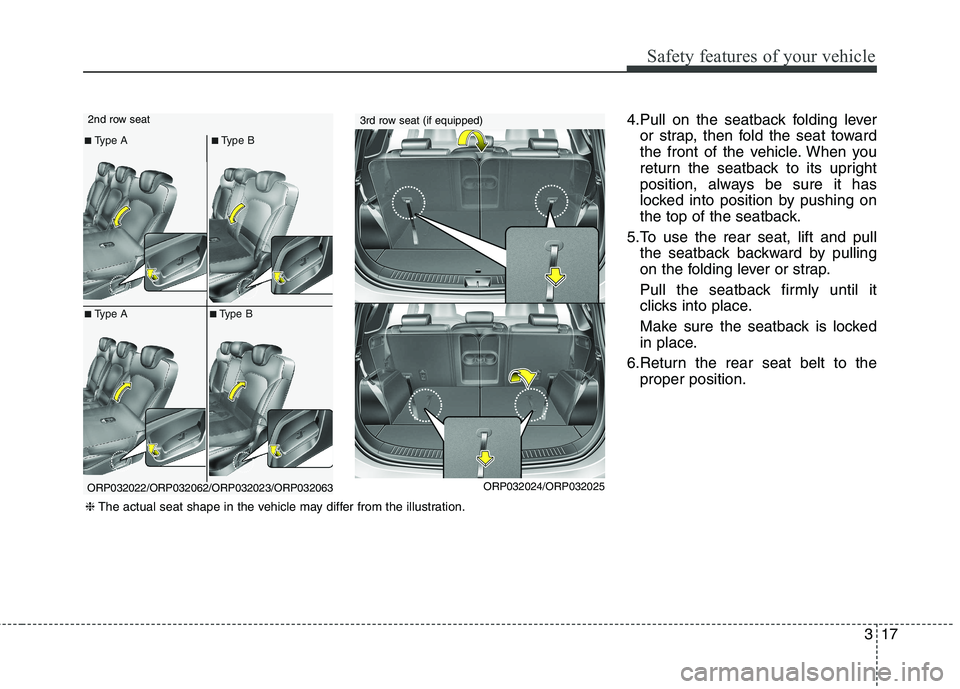
317
Safety features of your vehicle
4.Pull on the seatback folding leveror strap, then fold the seat toward
the front of the vehicle. When you
return the seatback to its upright
position, always be sure it has
locked into position by pushing on
the top of the seatback.
5.To use the rear seat, lift and pull the seatback backward by pulling
on the folding lever or strap.
Pull the seatback firmly until it
clicks into place.
Make sure the seatback is locked
in place.
6.Return the rear seat belt to the proper position.2nd row seat
ORP032022/ORP032062/ORP032023/ORP032063
❈The actual seat shape in the vehicle may differ from the illustration.
■Type A■ Type B
3rd row seat (if equipped)
ORP032024/ORP032025
■Type A ■
Type B
Page 37 of 723
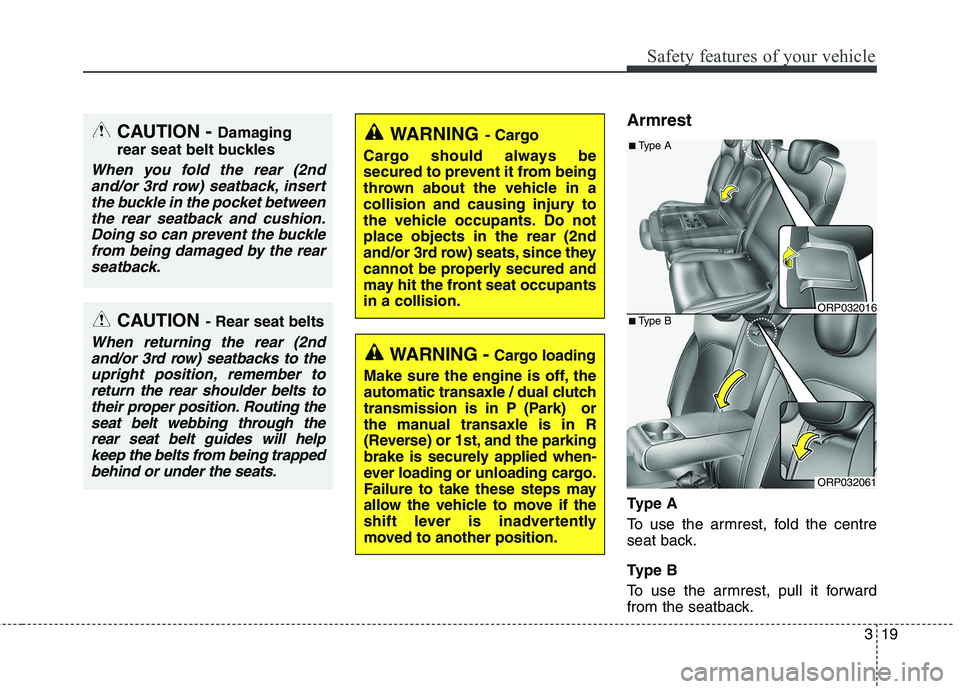
319
Safety features of your vehicle
Armrest
Ty p e A
To use the armrest, fold the centre
seat back.
Ty p e B
To use the armrest, pull it forward
from the seatback.
CAUTION- Rear seat belts
When returning the rear (2nd
and/or 3rd row) seatbacks to theupright position, remember to return the rear shoulder belts totheir proper position. Routing theseat belt webbing through the rear seat belt guides will helpkeep the belts from being trappedbehind or under the seats.
CAUTION - Damaging
rear seat belt buckles
When you fold the rear (2nd and/or 3rd row) seatback, insertthe buckle in the pocket between the rear seatback and cushion.Doing so can prevent the bucklefrom being damaged by the rear seatback.
WARNING - Cargo
Cargo should always be
secured to prevent it from being
thrown about the vehicle in a
collision and causing injury to
the vehicle occupants. Do notplace objects in the rear (2nd
and/or 3rd row) seats, since they
cannot be properly secured and
may hit the front seat occupantsin a collision.
WARNING - Cargo loading
Make sure the engine is off, the
automatic transaxle / dual clutch
transmission is in P (Park) or
the manual transaxle is in R
(Reverse) or 1st, and the parking
brake is securely applied when-
ever loading or unloading cargo.
Failure to take these steps may
allow the vehicle to move if the
shift lever is inadvertently
moved to another position.
ORP032061
ORP032016
■ Type A
■Type B
Page 40 of 723
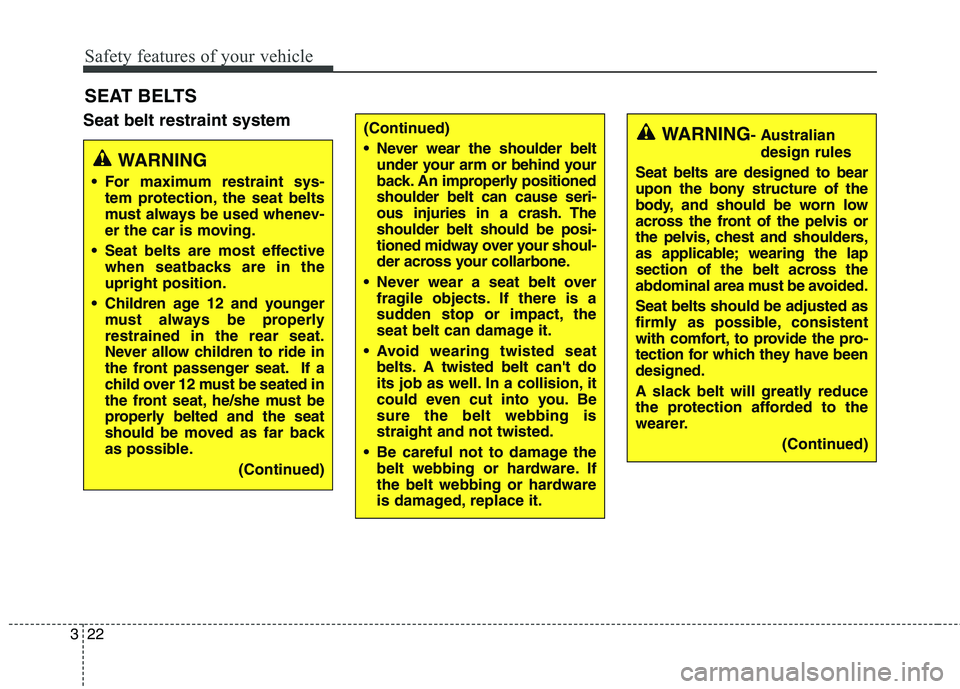
Safety features of your vehicle
22
3
Seat belt restraint system SEAT BELTS(Continued)
Never wear the shoulder belt
under your arm or behind your
back. An improperly positionedshoulder belt can cause seri-
ous injuries in a crash. Theshoulder belt should be posi-
tioned midway over your shoul-
der across your collarbone.
Never wear a seat belt over fragile objects. If there is a
sudden stop or impact, the
seat belt can damage it.
Avoid wearing twisted seat belts. A twisted belt can't do
its job as well. In a collision, it
could even cut into you. Besure the belt webbing isstraight and not twisted.
Be careful not to damage the belt webbing or hardware. If
the belt webbing or hardware
is damaged, replace it.WARNING - Australian
design rules
Seat belts are designed to bear
upon the bony structure of the
body, and should be worn low
across the front of the pelvis or
the pelvis, chest and shoulders,
as applicable; wearing the lap
section of the belt across the
abdominal area must be avoided. Seat belts should be adjusted as
firmly as possible, consistent
with comfort, to provide the pro-
tection for which they have beendesigned.
A slack belt will greatly reduce
the protection afforded to the
wearer.
(Continued)
WARNING
For maximum restraint sys- tem protection, the seat belts
must always be used whenev-
er the car is moving.
Seat belts are most effective when seatbacks are in theupright position.
Children age 12 and younger must always be properlyrestrained in the rear seat.
Never allow children to ride in
the front passenger seat. If a
child over 12 must be seated in
the front seat, he/she must be
properly belted and the seat
should be mo ved as far back
as possible.
(Continued)